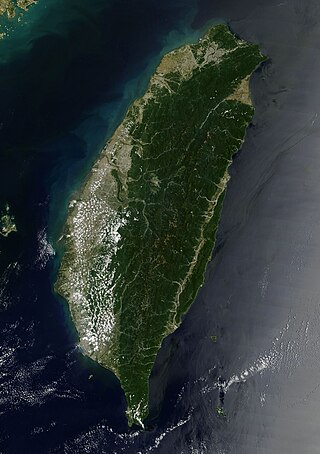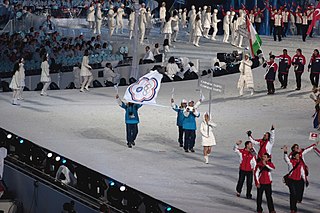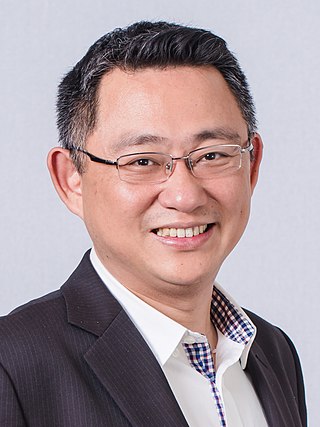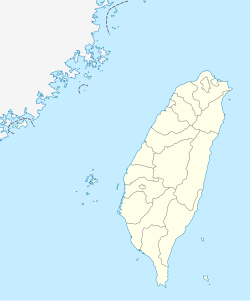
Taiwan, officially the Republic of China (ROC), is a country in East Asia, at the junction of the East and South China Seas in the northwestern Pacific Ocean, with the People's Republic of China (PRC) to the northwest, Japan to the northeast, and the Philippines to the south. The territories controlled by the ROC consist of 168 islands, with a combined area of 36,193 square kilometres (13,974 sq mi). The main island of Taiwan, also known as Formosa, has an area of 35,808 square kilometres (13,826 sq mi), with mountain ranges dominating the eastern two-thirds and plains in the western third, where its highly urbanised population is concentrated. The capital, Taipei, forms along with New Taipei City and Keelung the largest metropolitan area of Taiwan. Other major cities include Taoyuan, Taichung, Tainan, and Kaohsiung. With around 23.9 million inhabitants, Taiwan is among the most densely populated countries in the world.

Taiwan, officially the Republic of China (ROC), is an island country located in East Asia. The main island of Taiwan, formerly known in the West as Formosa, makes up 99% of the land area of the territories under ROC control. The main island measures 35,808 square kilometres (13,826 sq mi) and lies some 180 kilometres (112 mi) across the Taiwan Strait from the southeastern coast of the People's Republic of China (PRC). The East China Sea lies to the north of the island, the Philippine Sea to its east, the Luzon Strait directly to its south and the South China Sea to its southwest. The ROC also controls a number of smaller islands, including the Penghu archipelago in the Taiwan Strait, the Kinmen and Matsu Islands near the PRC's coast, and some of the South China Sea Islands.

The Taiwan independence movement is a political movement which advocates the formal declaration of an independent and sovereign Taiwanese state, as opposed to Chinese unification or the status quo in Cross-Strait relations.

Taipei, officially Taipei City, is the capital and a special municipality of the Republic of China (Taiwan). Located in Northern Taiwan, Taipei City is an enclave of the municipality of New Taipei City that sits about 25 km (16 mi) southwest of the northern port city of Keelung. Most of the city rests on the Taipei Basin, an ancient lakebed. The basin is bounded by the relatively narrow valleys of the Keelung and Xindian rivers, which join to form the Tamsui River along the city's western border.
The Three Links or Three Linkages was a 1979 proposal from the National People's Congress of the People's Republic of China (PRC) to open up postal, transportation, and trade links between Mainland China and Taiwan, with the goal of unifying Mainland China and Taiwan.

Kinmen, alternatively known as Quemoy, is a group of islands governed as a county by the Republic of China (Taiwan), off the southeastern coast of mainland China. It lies roughly 10 km (6.2 mi) east of the city of Xiamen in Fujian, from which it is separated by Xiamen Bay. Kinmen is located 187 km (116 mi) west from the shoreline of the island of Taiwan across the Taiwan Strait.

Taipei 101, formerly known as the Taipei World Financial Center, is a supertall skyscraper in Taipei, Taiwan. This building was officially classified as the world's tallest from its opening in 2004 until the 2009 completion of the Burj Khalifa in Dubai, UAE. Upon completion, it became the world's first skyscraper to exceed a height of half a kilometer. Taipei 101 is the tallest building in Taiwan.

"Chinese Taipei" is the term used in various international organizations and tournaments for groups or delegations representing the Republic of China (ROC), a country commonly known as Taiwan.

Cross-Strait relations are the relations between China and Taiwan.

The Taipei Grand Mosque or Taipei Zheng He Mosque is the largest and oldest mosque in Taiwan. Located in the Da'an District of Taipei City, it is Taiwan's most important Islamic structure.
Referendums in Taiwan at both the national and local level are governed by the Referendum Act of Taiwan, which was enacted by the Legislative Yuan in December 2003. Citizens can propose laws via referendums at the national and local levels. The Referendum Act also allowed people to make changes or abolish laws by referendums.
Events from the year 2011 in Taiwan, Republic of China. This year is numbered Minguo 100 according to the official Republic of China calendar.

The 1987 Lieyu massacre occurred on 7 March 1987, at Donggang Bay, Lieyu Island, Kinmen, Fujian, Republic of China. ROC military officially denied the massacre, and defined it as an incident of “mistaken killings” (誤殺事件), hence named as the March 7 Incident (三七事件) or Donggang Incident (東崗事件). There may have been more than nineteen deaths, including several families of ethnical Chinese Vietnamese.
Events from the year 1990 in Taiwan, Republic of China. This year is numbered Minguo 79 according to the official Republic of China calendar.
Events from the year 2015 in Taiwan, Republic of China. This year is numbered Minguo 104 according to the official Republic of China calendar.
The architecture of Taiwan can be traced back to stilt housing of the aborigines in prehistoric times; to the building of fortresses and churches in the north and south used to colonize and convert the inhabitants during the Dutch and Spanish period; the Tungning period when Taiwan was a base of anti-Qing sentiment and Minnan-style architecture was introduced; in Qing dynasty period, a mix of Chinese and Western architecture appeared and artillery battery flourished during Qing's Self-Strengthening Movement; During the Japanese rule of Taiwan, the Minnan, Japanese and Western culture were main influencers in architectural designs and saw the introduction and use of reinforced concrete. Due to excessive Westernization as a colony, after the retrocession of Taiwan to the Republic of China in 1945 from Japan at the end of World War II, Chinese classical style became popular and entered into international mainstream as a postmodern design style. Today, Taiwanese architecture has undergone much diversification, every style of architecture can be seen.

Yang Cheng-wu is a Taiwanese politician. He has served as Magistrate of Kinmen County since 25 December 2018, having won the office in the 2018 Taiwanese local elections. Prior to contesting the magistracy, Yang represented Kinmen County in the Legislative Yuan.
A pipeline supplies drinking water from Jinjiang City in Mainland China to Kinmen County in Fujian Province, Republic of China.

Taipei Heping Basketball Gymnasium is an indoor arena in the Daan District, Taipei City. The building is the home venue for the Taipei Fubon Braves of the P. LEAGUE+ (PLG) and ASEAN Basketball League. Taipei Heping Basketball Gymnasium opened on June 8, 2017, and seats 6,958 fans for Braves games.

The Beishan Old Western-style House is a historical house in Jinsha Township, Kinmen County, Taiwan.














